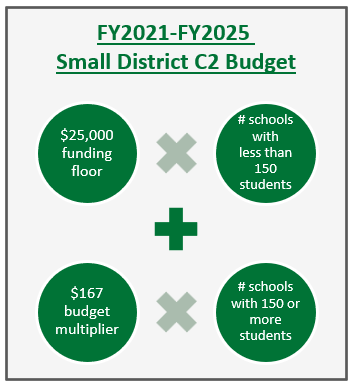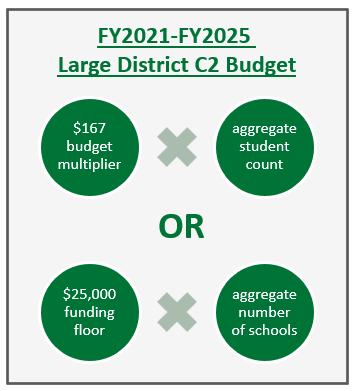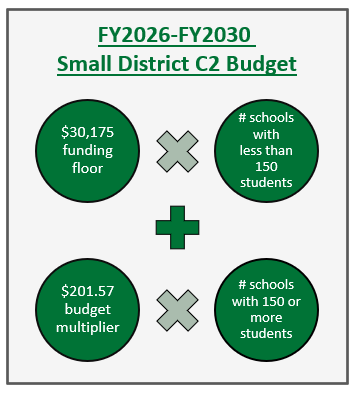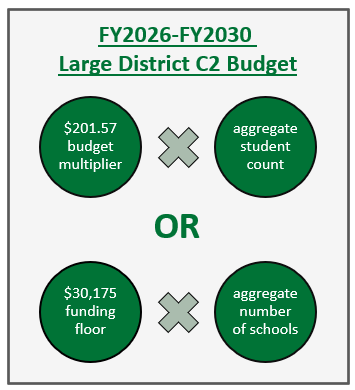![[Networkmaine Logo]](../images/nwm-erate-banner.png)
Applicants receiving Category Two funding support are subject to a fixed five year pre-discount budget for Category Two products and services.
The pre-discount cost of the products and services approved for E-Rate discounts is charged against the Category Two budget.
The following ONLY applies to Category Two. Category One services are not limited in cost or subject to a budget as long as they are cost-effective.
Category Two budgets run on a fixed five-year cycle.
Each five-year cycle term is the same for all applicants regardless of the first year in the cycle that they receive funding
Applicants may submit applications in any funding year during the five-year cycle.
An applicant's entire budget can be spent in one funding year or spread across any or all of the five funding years. For example, if the funding request in the first year is for less than the total five-year budget amount, the applicant can apply in the subsequent years for the remainder of their budget.
Each applicant's budget is established during the first year of the cycle that they receive a positive commitment for Category Two funding.
- In order to calculate their five-year budget, applicants must validate their student counts for each school in the district in the first year that applicant applies for Category Two support during the relevant five-year cycle.
- If they choose to do so, applicants can update their student counts in subsequent funding years to reflect, for example, an increased budget due to increased student enrollment.
Budget multipliers and the funding floor are established for each five-year budget cycle:
- Will be set once at the beginning of the cycle
- Will apply to the entire cycle
- Will always be rounded to two digits (dollars and cents)
- Will be adjusted for inflation at the beginning of the cycle
Funding commitments must be spent in the funding year in which they are awarded.
Products and services ordered in excess of an entity's Category Two budget will not receive E-Rate discounts.
Budget calculations are district-wide rather than at the school building or entity level and the district will have the flexibility to allocate Category Two funding among its schools as it sees fit.
Calculating Budgets:
Small school districts (this applies to virtually all Maine school district applicants) with 10 or fewer sites have the option to calculate their budgets on a per-site basis by adding together the budgets of each eligible school within the district. The budget is calculated by adding up the number of schools with less than 150 students times the funding floor AND the number of schools with 150 or more students times the budget multiplier.

Large school districts (very few Maine districts) will enter one aggregate district enrollment number without detailing the precise number of students attributable to any individual school. The budget is calculated by taking whatever number is larger: the budget multiplier times the aggregate student count of the district OR the funding floor times the aggregate number of schools in the district.

LEARN MORE  Learn more about the Category 2 Budgets for FY2021 - FY2025
Learn more about the Category 2 Budgets for FY2021 - FY2025
Budget Rules:
- All applicants will begin a new fixed five-year budget cycle and may submit applications in any funding year during the five-year cycle
- All applicant budgets will be reset beginning in FY2026
- Any unused Category 2 budget from the FY2021-2025 term will not rollover to this term
Calculating Budgets:
Small school districts (this applies to virtually all Maine school district applicants) with 10 or fewer sites have the option to calculate their budgets on a per-site basis by adding together the budgets of each eligible school within the district. The budget is calculated by adding up the number of schools with less than 150 students times the funding floor AND the number of schools with 150 or more students times the budget multiplier.

Large school districts (very few Maine districts) will enter one aggregate district enrollment number without detailing the precise number of students attributable to any individual school. The budget is calculated by taking whatever number is larger: the budget multiplier times the aggregate student count of the district OR the funding floor times the aggregate number of schools in the district.

LEARN MORE  Learn more about the Category 2 Budgets for FY2026 - FY2030
Learn more about the Category 2 Budgets for FY2026 - FY2030
USAC assumes that, if a commitment has been made on a Category 2 request, that the pre-discount amount of that request should be charged against the Category 2 budget.
Applicants can file an FCC Form 500 to return unused Category 2 funds. Unless funding is returned via an FCC Form 500, USAC assumes that the applicant is using the entire Category 2 funding that has been committed (not the amount disbursed via BEAR or SPI), and the full pre-discount amount of the committed funding request will remain charged against the entity's budget.
